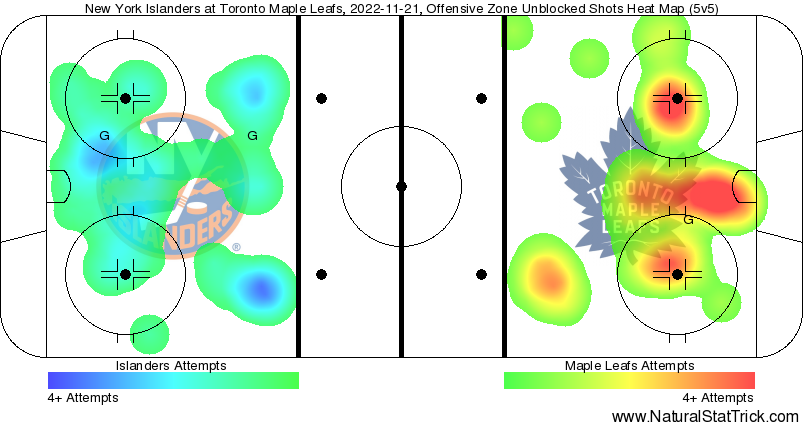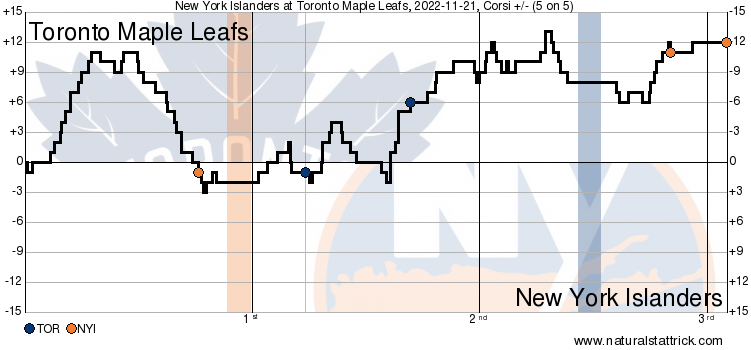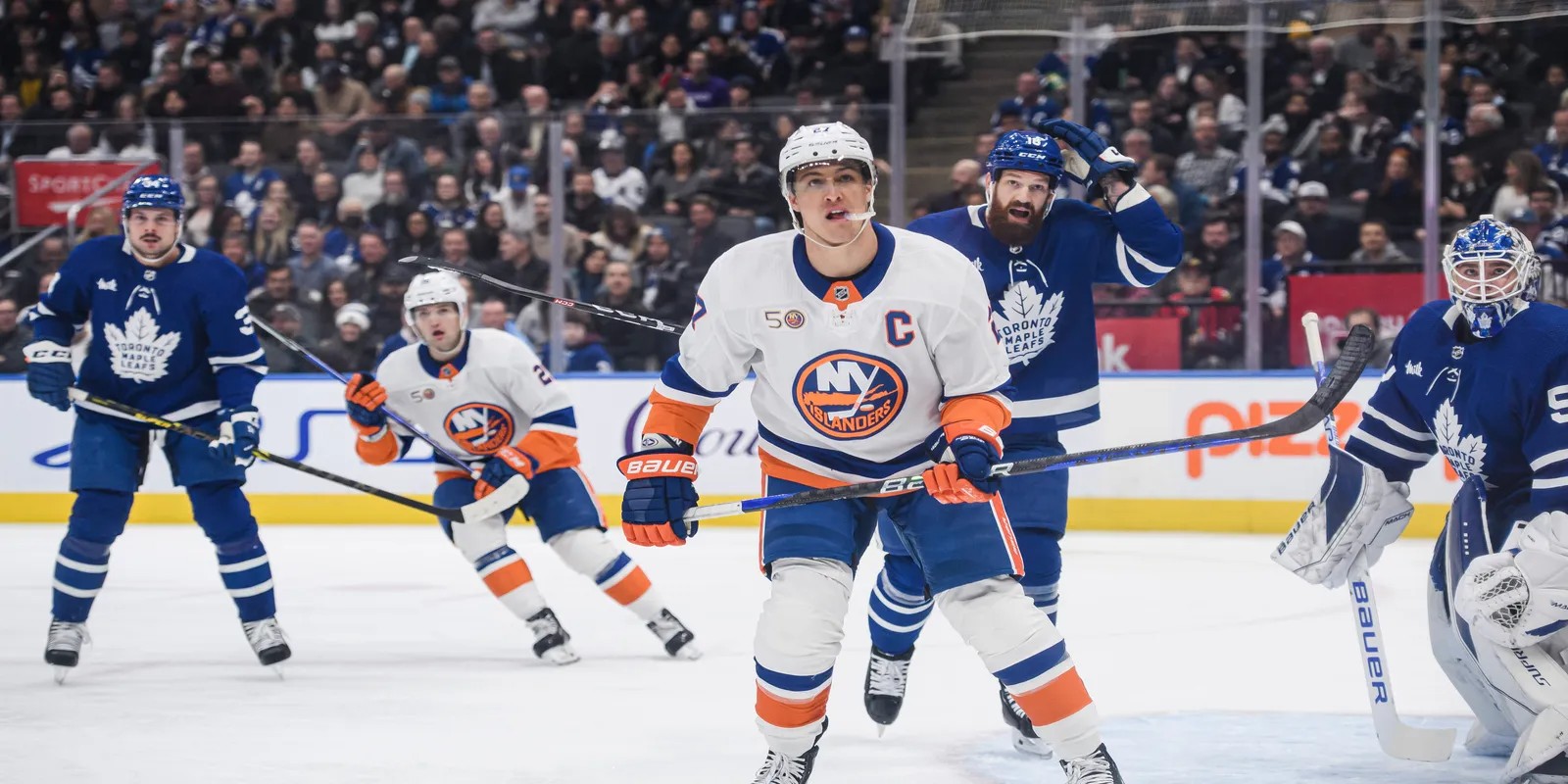The Maple Leafs did not shortchange us on effort in this one and actually played a good game, but they simply could not bury enough of their chances before a late goaltending mistake from Erik Källgren led to a dropped point. The three-on-three overtime faceplants continue.
Let’s hope Morgan Rielly is okay.
Your game in 10:
1. This was as good of a start as we’ve seen from the Leafs in terms of puck possession in the offensive zone. Much of the first 10 minutes felt like a Toronto power play. William Nylander rang the crossbar. John Tavares missed one just wide off his backhand in tight. At one point, Mitch Marner curled away from the net with the puck despite a half-empty net to shoot at (for some reason). On one of the Islanders’ first forays in the offensive zone, Calle Järnkrok broke the other way on a 2v1, but he lost the handle.
The Leafs couldn’t finish at even strength (stop me if you’ve heard that one before), and once the Islanders woke up halfway through the period, you had the sinking feeling the Leafs were conceding the opening goal the other way. That is exactly what happened on a point shot leading to a deflection off of David Kämpf in front. Erik Källgren had no chance on the goal.
Alex Kerfoot was sent in alone by Marner after the Leafs went down 1-0, but he remains snakebitten around the net, although it’s not just bad luck — he’s had some terrible finishing attempts on free-and-clear looks during this stretch. That extended Kerfoot’s goalless drought to 15 games despite playing most of it on one of the Leafs‘ top two lines next to offensive studs.
2. The goal against started with a turnover inside the offensive blue line by Denis Malgin, who also failed to get a puck in deep at the end of a long shift a little bit earlier. He’s been a nice complement to the line overall with his ability to hold onto pucks and create offense, and you do want him to play to his strengths by making some plays, but the reality of checking-line life is that he is going to have to pick his spots on that line, be patient at times with his offense, and make sure he is getting those little details right.
Further, Keefe wants David Kampf and Zach Aston-Reese on a checking line he can fully trust in defensive situations against good players, and that likely means he’ll eventually prefer them with a regular linemate that he can truly depend on defensively. That’s the awkward situation for Malgin in the long run here as much as he has given the line a nice offensive presence at times.
3. To their credit, the Leafs did not come out for the second period discouraged in the least and got right back to work, owning the lion’s share of the puck possession. Successive offensive-zone shifts set up a third-line shift that saw the Leafs go to work down low, where Pierre Engvall drew a penalty. Late in the first period and early in the second period, you could hear a pin drop (and just about every word shouted on the ice) in the SBA, but a big push to start the second got the crowd loud and back into it.
On the subsequent power play, the Leafs worked a perfect down-low triangle passing play between Mitch Marner on the faceoff dot, William Nylander below the goal line, and John Tavares in the slot to make it 1-1. Last season, we saw the Leafs integrate this high-to-low power-play wrinkle more often, with a pass from below the goal line to the net-front/bumper player fading away from the net for a one-timer. Perfect execution there.
Power play perfection 🤌 pic.twitter.com/gpdquIjMwc
— Toronto Maple Leafs (@MapleLeafs) November 22, 2022
Tavares continues to feast this season with 11 goals in 20 games, including goals from the slot on the power play in back-to-back games.
4. The Leafs continued to ragdoll the Islanders in the subsequent shifts after the tying goal, with Mitch Marner, in particular, dancing around the offensive zone with the puck setting up scoring chances at will.
Similar to the first period, the Leafs could not convert at five-on-five, and the Islanders settled into the period around the midway point for a couple of offensive-zone shifts and a few shots on goal, but there was nothing too threatening about it.
5. We wondered if Sheldon Keefe would go back to it after the third period against New Jersey, and if his answer about it the next day wasn’t a surefire indication, this definitely was. As the Leafs got back on the front foot in the second half of the second period, on an offensive zone faceoff coming off of an icing, Keefe used Mitch Marner on defense in a 1-1 game alongside the loaded-up forward line of John Tavares, Auston Matthews, and William Nylander. The Leafs lost the draw, and Marner quickly subbed off for Rasmus Sandin.
Just seconds later, finally, the 5v5 breakthrough arrived for Auston Matthews, who applied a perfect tip into the far corner. It was an impressive show of patience and shot-for-tip from Timothy Liljegren, and a good call by Keefe to recognize the ice was tilted in his favour and get his loaded line out there at a time when the Leafs were pressing to take control of the game.
On top of the number of times he simply beat a goalie with his shot, we saw Matthews score a lot of 5v5 goals off of tips, redirects, and deflections in his 60-goal season last year. He scored one that way vs. Washington this season (which was kind of an accident), but that was a long time ago. It looks like the 5v5 shooting percentage is starting to take the on-ramp to some long-overdue positive regression.
TONY TIPS! pic.twitter.com/B1XJ6mANCe
— Toronto Maple Leafs (@MapleLeafs) November 22, 2022
6. It was another good first shift to open a period in the third as the Leafs started with Calle Järnkrok up next to Auston Matthews due to the Michael Bunting double minor, earned in a scrum with Scott Mayfield and Cal Clutterbuck before the intermission. Morgan Rielly nearly scored his first of the season on a nice drive and backhand attempt, followed by a dangerous wraparound attempt by Matthews.
Unfortunately, Rielly left the game shortly afterward due to an accidental collision with Kyle Palmieri in the neutral zone, and it looked like it might have been a case of Rielly clipping his knee. Especially with TJ Brodie already on the sidelines and experiencing a setback in his recovery, let’s hope it was mostly precautionary.
Rielly has been something of an ironman for the Leafs over recent years to the point where we almost take him for granted. Needless to say, it would be a lot for the Leafs (or any team) to overcome any sort of long-term absence of what was their top pairing for large portions of the past few years.
7. With the Islanders chasing the game, they were starting to push and the momentum was starting to shift a little, with Mathew Barzal, in particular, taking over a couple of shifts. Barzal nearly set up a scoring chance in the slot, but a hard backcheck by Michael Bunting broke it up and sent Auston Matthews on a rush the other way, where Oliver Wahlstrom clipped him as he cut into the slot (Matthews was okay).
There was an instant response by Rasmus Sandin, who confronted Wahlstrom immediately. It looked like Sandin mostly wanted to give Wahlstrom a shove and a few choice words, but the Isles forward instantly had the gloves off ready to go, and Sandin obliged.
The expectation is not that every Leafs player needs to instantly pound on a player who touches Matthews or another Leafs star; most importantly, Sandin didn’t ignore it or turn away from it, which is what really counts. The Scotiabank Arena gave Sandin a standing ovation for it. Fans in this market will always greatly appreciate this kind of response in its team (i.e. teammates having one another’s backs), and you could tell Matthews did, too.
The Leafs actually went to a power play for a too-many-men call after all of the chaos, and Mitch Marner had a glorious chance at the side of the net to put the game more or less to bed. He couldn’t elevate the puck enough, and Ilya Sorokin came up with a huge save to keep his team in it. Another costly missed opportunity for the Leafs there in hindsight.
8. The fallout from not converting on that power play was that the Leafs were now up against it with Rasmus Sandin in the box for five minutes and Morgan Rielly out, dropping them to four defensemen. The Isles started to tilt the ice for a spell, but Erik Källgren held steady with a lot of support from the Leafs defending hard within their structure and blocking shots even as they ate some zone time against.
It was seemingly working its way toward a white-knuckle finish, although it was encouraging that the Leafs got back on the front foot for a couple of shifts inside the final five minutes. Denis Malgin and Calle Järnkrok both had clear-cut scoring chances from the slot to put the game away, but they fired wide/high. One of those has to go in.
9. The inability to build a cushion on the scoreboard ended up biting the Leafs due to an Erik Källgren misplay behind his net directly leading to Josh Bailey beating him shortside to tie the game.
It was a simple case of a goaltending error that was magnified by the Leafs failing to take enough of their chances in the game, although I don’t think it should totally detract from the fact that the Leafs played a really good game of playoff-style hockey up until that point.
They really defended hard as a team at five-on-five, giving up basically nothing easy in the way of odd-man rush opportunities or breakaways against, and made it difficult on the Isles to generate in-zone. William Nylander and Mitch Marner both made good plays when tracking back to break up dangerous-looking plays in the third period (as did Michael Bunting). They were committed to coming back hard, battling physically, blocking shots, and seeing the win out. They allowed just 24 shots on goal and controlled over 70% of the high-danger chances.
The Marner backcheck was a great example of how much the commitment defensively by the forwards — led by the big guns — is making life easier on the defense core as Justin Holl could shift over and pick off the pass.
The Leafs just needed to find a way to bear down on their chances better than they did, and Källgren blew it after another solid (if not particularly busy) game for him.
10. Speaking of blowing it, what do you even say about the team’s three-on-three overtime play at this point? They’re now 1-5 this season, and it doesn’t seem to matter who Sheldon Keefe puts out there. With Morgan Rielly out of the game, he started Auston Matthews, William Nylander, and Timothy Liljegren.
The Leafs iced it twice, Nylander sloppily turned it over for a 2v1 against, and then when Mitch Marner and John Tavares came over the boards, Marner threw it away with a blind pass shortly before a beautiful Anthony Beauvillier game-winner.
Sheldon Keefe even admitted the other day that the three-on-three OT play has gotten so bad to the point where they’ve been forced to dedicate some time to it in practice when he really rather focus on other priorities. I wrote this after the last couple of OT losses, but the Leafs are terribly irresponsible when managing the puck in OT, where puck possession is everything. It’s like they kick into, “It’s shinny mode, time to get goofy!” and embarrass themselves every time.
Heat Map: 5v5 Shot Attempts

Game Flow: 5v5 Shot Attempts





































